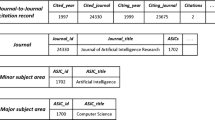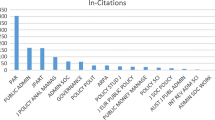Abstract
While there is a consensus that there is a core-periphery structure in the global scientific enterprise, there have not been many methodologies developed for identifying this structure. This paper develops a methodology by looking at the differences in the power law structure of article outputs and degree centrality distributions of countries. This methodology is applied to five different scientific fields: astronomy and astrophysics, energy and fuels, nanotechnology and nanosciences, nutrition, and oceanography. This methodology uncovers a two-tiered power law structure that exists in all examined fields. The core-periphery structure that is unique to each field is characterized by the core’s size, minimum degree, and exponent of its power law distribution. Stark differences are identified between technology and non-technology intensive scientific fields.




Similar content being viewed by others
Notes
England, Wales, and Scotland are treated as separate entities in WoS and were combined into the United Kingdom. Additionally, East and West Germany were combined into a single entity prior to 1989.
The cause for this discrepancy was not investigated. However, the author hypothesizes that part of this discrepancy may come from the fact that WoS includes a large number of professional journals.
References
Amaral, L. A. N., & Ottino, J. M. (2004). Complex networks: Augmenting the framework for the study of complex systems. European Physical Journal B, 38, 147–162.
Barabasi, A. L., Jeong, H., Neda, Z., Ravasz, E., Schubert, A., & Vicsek, T. (2002). Evolution of the social network of scientific collaborations. Physica A, 311, 590–614.
Ben-David, J. (1971). The scientist’s role in society. NJ: Prentice-Hall.
Borgatti, S. P., & Everett, M. G. (1999). Models of core/periphery structures. Social Networks, 21, 375–395.
Cioffi-Revilla, C. (Eds.). Power laws in the social sciences: Discovering complexity and non-equilibrium dynamics in the social universe. Publication forthcoming.
De Solla, D. J. (1965). Networks of scientific papers. Science, 149(3683), 510–515.
Georghiou, L. (1998). Global cooperation in research. Research Policy, 27, 611–626.
Glänzel, W. (2001). National characteristics in international scientific co-authorship relations. Scientometrics, 51(1), 69–115.
Glänzel, W., & Schubert, A. (2004). Analyzing scientific networks through co-authorship. In H. F. Moed, W. Glänzel, & U. Schmoch (Eds.), Handbook of quantitative science and technology research. The use of publication and patent statistis in studies of S&T systems (pp. 257–276). Dordrecht: Kluwer Academic Press.
Glänzel, W., Debackere, K., & Mayer, M. (2008). ‘Triad’ or ‘tetrad’? On global changes in a dynamic world. Scientometrics, 74(1), 71–88.
Hill, C.T. (2007). The post-scientific society. Issues in Science and Technology, 24(1).
Holland, J. (1998). Emergence: From chaos to order. New York: Helix Books.
Hwang, K. (2008). International collaboration in multilayered center-periphery in the globalization of science and technology. Science Technology Human Values, 33, 101–133.
Jeong, H., Neda, A., & Barabasi, A.L. (2001). Measuring preferential attachment for evolving networks. arXiv:cond-mat/0104131 v1, 7 April 2001.
Katz, J. S., & Hicks, D. (1997). How much is a collaboration worth? A calibrated bibliometric model. Scientometrics, 40(3), 541–554.
King, D.A. (2004). The scientific impact of nations. Nature, 432.
Lall, S. (2001). Competitiveness indices and developing countries: An economic evaluation of the global competitiveness report. World Development, 29(9), 1501–1525.
Leydesdorff, L., & Wagner, C. S. (2008). International collaboration in science and the formation of a core group. Journal of Informetrics, 2(4), 317–325.
Lotka, A. J. (1926). The frequency distribution of scientific productivity. Journal of the Washington Academy of Sciences, 16(12), 317–324.
Newman, M. E. J. (2001). The structure of scientific collaboration networks. Proceedings of the National Academy of Sciences, 98, 404–409.
Newman, M. E. J. (2004). Co-authorship networks and patterns of scientific collaboration. Proceedings of the National Academy of Sciences, 101(Suppl. 1), 5200–5205.
Ohmae, K. (1985). Triad Power: The Coming Shape of Global Competition. New York: Free Press.
Oldham, G. (2005). Policy brief: International scientific collaboration: a quick guide, science and development network.
Schott, T. (1993). World science: Globalization of institutions and participation. Science, Technology and Human Values, 18, 196–208.
Schott, T. (1998). Ties between center and periphery in the scientific world system. Journal of World-Systems Research, 4, 112–144.
Serrano, M. A. (2008). Rich-club vs. rich-multipolarization phenomena in weighted networks. Physical Review E, 78, 026101.
Traweek, S. (1988). Beamtimes and lifetimes: The world of high energy physicists. Cambridge, MA: Harvard University Press.
Wagner, C. S. (2005). Six case studies of international collaboration in science. Scientometrics, 62(1), 3–26.
Wagner, C. S. (2008). The new invisible college: Science for development. Washington DC: Brookings Institution Press.
Wagner, C. S., & Leydesdorff, L. (2005). Network structure, self-organization, and the growth of international collaboration in science. Research Policy, 34(10), 1608–1618.
Wagner-Döbler, R. (2001). Continuity and discontinuity of collaboration behaviour since 1800—from a bibliometric point of view. Scientometrics, 52, 503–517.
Zelnio, R. (2011). Structure of international scientific collaboration. In E. Noyons, P. Ngulube, J. Leta (Eds), Proceedings of ISSI 2011—the 13th International Conference on Scientometrics and Informetrics, Durban, South Africa (pp. 898–913).
Zhou, S., & Mondragón, R. J. (2004). The rich-club phenomenon in the internet topology. IEEE Communication Letters, 8(3), 180–181.
Acknowledgments
An extended version of a paper presented at the 13th International Conference on Scientometrics and Informetrics, Durban (South Africa), 4–7 July 2011 (Zelnio 2011).
The author would like to thank the conference attendees and the anonymous conference reviewers for their comments, many of which were incorporated.
Author information
Authors and Affiliations
Corresponding author
Rights and permissions
About this article
Cite this article
Zelnio, R. Identifying the global core-periphery structure of science. Scientometrics 91, 601–615 (2012). https://doi.org/10.1007/s11192-011-0598-0
Received:
Published:
Issue Date:
DOI: https://doi.org/10.1007/s11192-011-0598-0




